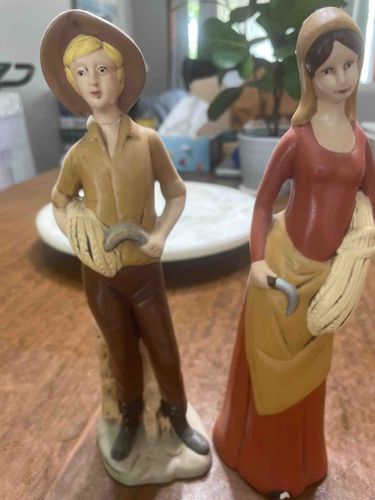
Pair of Vistrex Plaster Harvest Figurines
This is a pair of painted plaster figurines identified as 'Vistrex' plaster figurines, depicting a male and a female figure, likely designed to represent agricultural workers or harvest time. The male figure, positioned on the left, is wearing a light brown or tan wide-brimmed hat, a matching long-sleeved shirt, and dark brown trousers and boots. He holds a bundle of what appears to be wheat or hay in his left arm and a small, curved sickle in his right hand, suggesting a harvesting theme. His hair is painted yellow, and his facial features are simply rendered with light skin tone. The female figure, on the right, is depicted with light brown hair covered by a darker brown or reddish headscarf. She wears a long-sleeved reddish-brown blouse or dress with a lighter yellow apron or overskirt. Similar to the male figure, she also holds a bundle of crops and a sickle. Both figures stand on integrated, irregular bases painted in a light, off-white color, mimicking natural ground. The paint application appears to be matte or semi-matte, with some visible brushstrokes, indicating hand-painting. Observable condition issues include a small chip on the base of the female figurine and a chip on the back of the male figure, suggesting minor surface damage to the plaster. These chips are described as 'easily repairable,' implying they are cosmetic and do not compromise the overall structural integrity of the figurines. The manufacturer's mark, identified as 'Vistrex,' is present on both pieces, confirming their origin. Given the style and material (painted plaster), these figurines likely date from the mid-20th century, possibly Post-War era (1940s-1960s), a common period for home decorative items of this nature. The craftsmanship appears to be folk art or factory-produced decorative ware, aiming for aesthetic appeal rather than fine art detail. The figures' poses are static but convey their intended roles as harvesters.
AI-Generated Appraisal Disclaimer
Estimated Value
$50 - $100
Basic Information
Category
Decorative Figurines
Appraised On
December 7, 2025
Estimated Value
$50 - $100
Additional Details Provided By Owner
User Provided Information
Pair of vistrex plaster painted figurines. Small chip on base with woman and back of boy both easily repairable Both are marked with manufacturer mark
Item Description
This is a pair of painted plaster figurines identified as 'Vistrex' plaster figurines, depicting a male and a female figure, likely designed to represent agricultural workers or harvest time. The male figure, positioned on the left, is wearing a light brown or tan wide-brimmed hat, a matching long-sleeved shirt, and dark brown trousers and boots. He holds a bundle of what appears to be wheat or hay in his left arm and a small, curved sickle in his right hand, suggesting a harvesting theme. His hair is painted yellow, and his facial features are simply rendered with light skin tone. The female figure, on the right, is depicted with light brown hair covered by a darker brown or reddish headscarf. She wears a long-sleeved reddish-brown blouse or dress with a lighter yellow apron or overskirt. Similar to the male figure, she also holds a bundle of crops and a sickle. Both figures stand on integrated, irregular bases painted in a light, off-white color, mimicking natural ground. The paint application appears to be matte or semi-matte, with some visible brushstrokes, indicating hand-painting. Observable condition issues include a small chip on the base of the female figurine and a chip on the back of the male figure, suggesting minor surface damage to the plaster. These chips are described as 'easily repairable,' implying they are cosmetic and do not compromise the overall structural integrity of the figurines. The manufacturer's mark, identified as 'Vistrex,' is present on both pieces, confirming their origin. Given the style and material (painted plaster), these figurines likely date from the mid-20th century, possibly Post-War era (1940s-1960s), a common period for home decorative items of this nature. The craftsmanship appears to be folk art or factory-produced decorative ware, aiming for aesthetic appeal rather than fine art detail. The figures' poses are static but convey their intended roles as harvesters.
Get Your Items Appraised
Instant estimates of your treasures with AI-powered instant appraisals